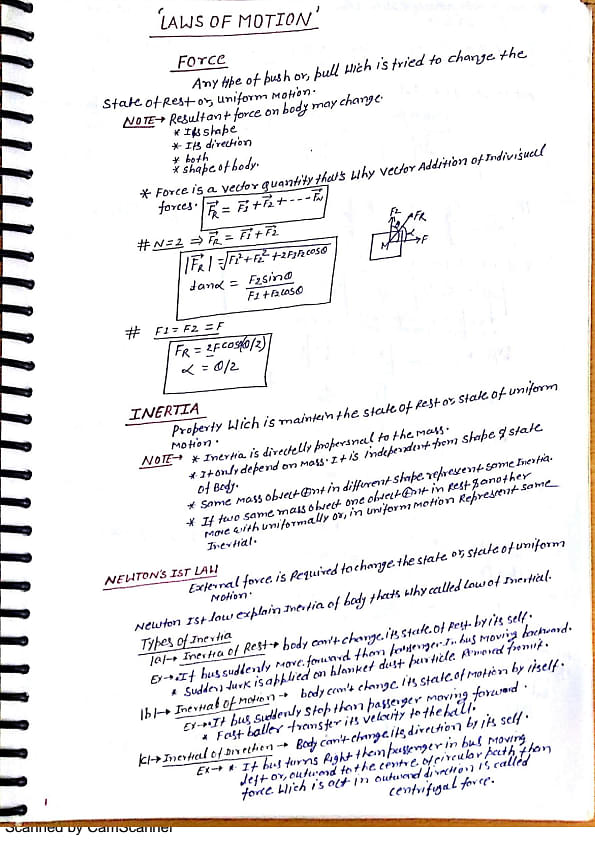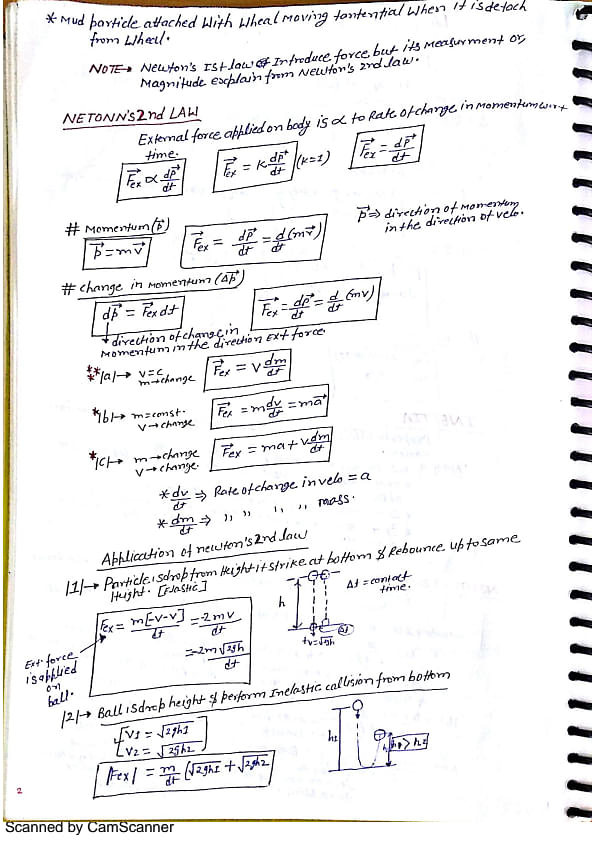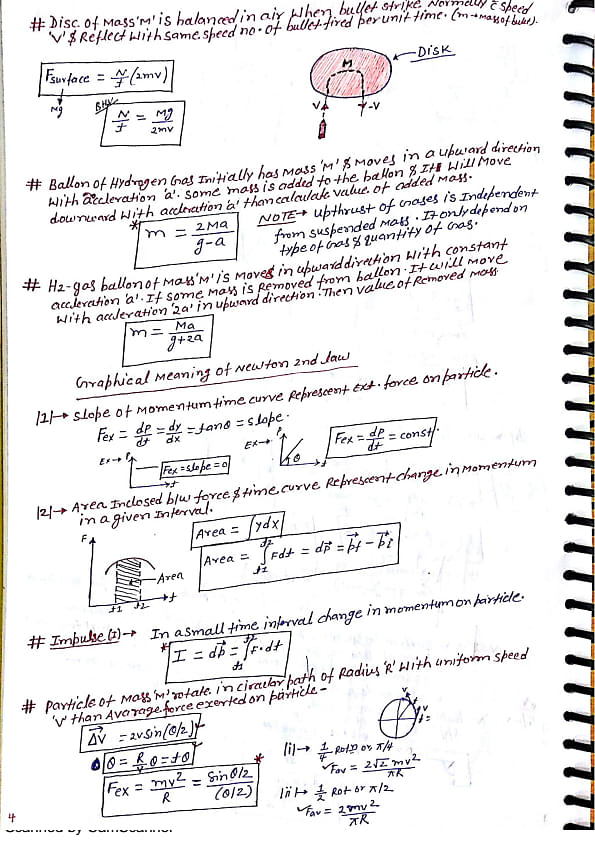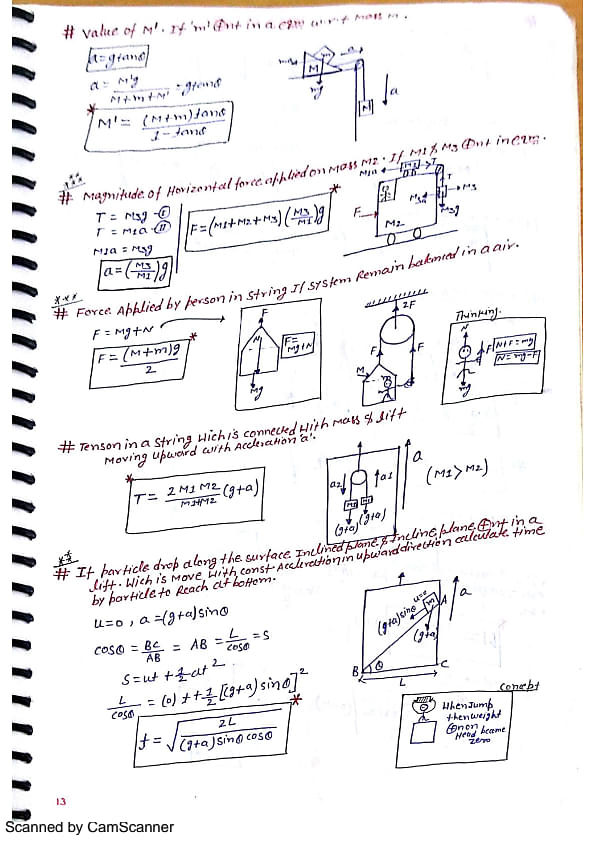Muskan Shafi Education Content Expert
Education Content Expert
Inertia is a property of a body that opposes any force that tries to move or modify the amplitude or direction of the motion of a body that is already moving. Inertia is a passive property that prevents a body from doing anything other than resisting pressure and torque. Law of Inertia states that if a body is at rest or moving at a constant speed in a straight line, it will remain so unless it is acted upon by a force.
- The inertia of a body is measured by the mass of the body.
- The heavier the mass, the greater the required force. Hence, the greater will be the inertia.
- Law of Inertia is also known as Newton’s First Law of Motion.
There are two numerical measures of a body's inertia namely its mass and its moment of inertia about a certain axis, which measures its resistance to the action of a torque about the same axis which governs its resistance to the action of a force.
Read More: NCERT Solutions For Class 11 Physics Laws of Motion
| Table of Content |
Key Terms: Inertia, Law of Inertia, Force, Acceleration, Resistance, Pressure, Motion, Friction, Newton’s First Law of Motion
What is Inertia?
[Click Here for Sample Questions]
Inertia is the fundamental property of all bodies that prevents them from changing their state of rest or uniform motion along a straight line on their own.
- Inertia is defined as the tendency to resist changes in the state of motion.
- Inertia is Newton’s First Law of Motion and is considered to be a fundamental principle of Physics.
- Aristotle first proposed the idea that a body must be kept in motion by an external force.
- However, he overlooked the fact that an opposing frictional force acts on the body to counteract the external force, resulting in a net force of zero on the body.
Read More:
| Relevant Concepts | ||
|---|---|---|
| Force and Laws of Motion | Newton’s Third Law of Motion | Effects of Forces |
| Aristotle Fallacy | Impending Motion | Force and Acceleration |
Law of Inertia
[Click Here for Previous Years’ Questions]
Law of Inertia is a fundamental law in Physics which is also known as Newton’s First Law of Motion. Law of Inertia states that,
| “If a body is at rest or moving in a straight line at a constant speed, it will remain at rest or continue to move in a straight path at a constant speed until it is acted with by a force.” |
Galileo Galilei first proposed the law of inertia for horizontal motion on Earth, and René Descartes later generalized it.
- Prior to Galileo, it was considered that all horizontal motion required a direct cause.
- However, Galileo reasoned from his tests that a body in motion would stay in motion unless a force (such as friction) would bring it to a halt.
- This laid the foundation for the first of Newton’s Laws of Motion.
- The principle of inertia is the starting point and fundamental assumption of classical mechanics.
- Objects that are not being pushed tend to come to a halt in Aristotelian mechanics and everyday life.
- Galileo derived the law of inertia from his studies with balls rolling down inclined surfaces.
- The mass of a body is used to calculate its inertia.
- The higher the mass, the greater the force required, and hence the greater the inertia, and vice versa.
Examples of Inertia
[Click Here for Sample Questions]
Some real-life examples of the law of inertia are as follows:
- The sudden start of a lift is an example of inertia.
- We fall backward when a bus begins unexpectedly. It happens as our lower body begins to move with the vehicle while our upper body struggles to stay still.
- When the bus suddenly stops or slows down, we tend to lean forward.
- Mango falls off the tree upon shaking the mango tree.
- When a car abruptly goes around a curve, the driver is flung outside.
Laws of Motion Detailed Video Explanation
Types of Inertia
[Click Here for Previous Years’ Questions]
Inertia is classified into three major types as follows:
Inertia of Rest
The body's reluctance to remain in a condition of rest until some external force acts on it is known as the inertia of rest.
Example of Inertia of Rest: When we beat the carpet, dust particles in the state of rest are thrown into motion. This is due to the fact that dust particles tend to stay at rest and hence become separated.
Inertia of Direction
When the body offers resistance to continue moving in the same direction until an external force acts on it, this is called inertia of direction.
Examples of Inertia of Direction
- Unless we turn the bike's handle, it tends to move in a straight way.
- When one end of a string linked to the stone is spun. The string snaps and the stone fly off in a tangent to the circle. This is because the stone was being forced to move in a circular manner by the string's pull. The pull diminishes as soon as the string breaks, and the stone flies off in a tangential direction.
Read More: Laws of Motion MCQs
Inertia of Motion
When the body provides resistance to continue in a regular motion unless an external force acts on it.
Examples of Inertia of Motion
- We tumble forward when a train comes to a quick stop. The top part of the body is in touch with the seat and begins to move with the train due to inertia of motion, while the lower section seeks to remain at rest.
- A person leaps from a train and lands on his or her feet. This is due to the fact that his feet are in contact with the ground and remain still while the rest of his body continues to move due to inertia.
Galileo’s Free Fall Experiment
[Click Here for Sample Questions]
Galileo hypothesized that a falling object gains an equal amount of velocity in equal intervals of time. This means that the speed increases at a constant rate as it falls. However, it was impossible for Galileo to observe the free-falling motion of the object as technology was unable to record such high speeds at that time.
- Galileo attempted to decelerate the motion by replacing the falling object with a ball that rolls down an inclined plane.
- He assumed that a ball rolling down a ramp would speed up in the same way as a falling ball would.
- Galileo measured the time it took for the rolling ball to reach a specific distance down the inclined plane.
- He observed that the time it took for the ball to roll across the ramp was equal to double the amount of time it took for it to only roll a quarter of the distance.
- Therefore, if you were to double the amount of distance the ball traveled, it would travel four times as far.
Through this experiment, Galileo concluded that
| If an object is released from rest and gains speed at a steady rate, then the total distance traveled by the object is directly proportional to the time squared needed for that travel. |
Mathematically, this is expressed as
| \(s\propto t^2\). |
Read More:
Laws of Motion Class 11 Handwritten Notes
[Click Here for Previous Years' Questions]
Given below are the handwritten notes covering the important concepts of the Laws of Motion:















Things to Remember
- Inertia is a property that prevents a body from resisting changes in its state of motion.
- Newton’s Law of Inertia states that a body tends to be in a state of rest or of uniform motion until an external force acts on it.
- There are three types of inertia namely Inertia of Rest, Inertia of Direction, and Inertia of Motion.
- Inertia of rest is the body's reluctance to remain in a condition of rest until some external force acts on it.
- Inertia of direction is when the body offers resistance to continue moving in the same direction until an external force acts on it.
- Inertia of motion is when the body provides resistance to continue in a regular motion unless an external force acts on it.
-
The sudden start of a lift is one of the most common examples of Inertia.
Previous Years’ Questions
- A disc rotates about its axis of symmetry in a horizontal plane at a steady rate of 3.5 revolutions… (JEE Main – 2018)
- A block of mass 5 kg resting on a horizontal surface is connected by a cord... (KEAM – 2019)
- A body of mass 2kg slides down with an acceleration of 3m/s2 on a rough inclined… (JEE Main – 2018)
- A block of mass of 10 kg is kept on a rough inclined plane as shown in the figure. A force of… (JEE Main – 2019)
- A block kept on a rough inclined plane, as shown in the figure, remains at rest up to a maximum… (JEE Main – 2019)
- A block of mass 10 kg, initially at rest, makes a downward motion on… (TS EAMCET – 2019)
- Figure represents the position-time graph of a body of mass... (AMUEEE – 2018)
- A block is placed on a rough horizontal plane. A time-dependent horizontal force F = kt acts… (JEE Main – 2013)
- A body of mass 5kg under the action of constant force… (JEE Main – 2014)
- A block rests on a rough inclined plane making an angle of 30∘ with the horizontal… (KCET – 2018)
Sample Questions
Ques. What is Inertia of a Body? (2 Marks)
Ans. Inertia refers to a body's innate tendency to resist changes in its state. Inertia is a notion that states that an object will continue its current motion until some force causes its speed or direction to change. Inertia has been described by Newton in his first law of motion.
Ques. State the types of Inertia. (3 Marks)
Ans. There are three types of Inertia as follows:
- Inertia of Rest: It occurs when the resistance is offered by the body to continue in the state of rest unless an external force acts on it.
- Inertia of Direction: It occurs when the resistance is offered by the body to continue the motion in the same direction unless an external force acts on it.
- Inertia of Motion: It occurs when the resistance is offered by the body to continue to be in uniform motion unless an external force acts on it.
Ques. What are factors affecting Moment of Inertia? (2 Marks)
Ans. The factors affecting Moment of Inertia are as follows:
- Density of the material.
- Shape and Size of the Object or Body
- Axis of Rotation
Ques. What is the Importance of Inertia? (2 Marks)
Ans. Inertia has practical use in day-to-day activities. It is used for:
- To comprehend any physical object's unwillingness to change its status.
- For example, with the Mars mission, all we required was fuel to free the rocket from gravitational attraction and slow it down after it arrived on Mars.
- Inertia played a significant role in this mission, as it carried the rocket 54.6 million kilometers in space from Earth to Mars without using any fuel.
Ques. Is Inertia a Force? (2 Marks)
Ans. Yes, inertia is a force that maintains stationary things at rest and moving objects traveling in the same direction at the same speed.
- In an ideal world, an object in a gravity-free environment would have no inertia.
- As a result, inertia is a physical object's natural tendency to resist motion, eventually bringing the body to a state of rest.
Ques. State Newton’s Law of Inertia. (1 Mark)
Ans. Newton’s Law of Inertia is also referred to as Newton’s First Law of Motion. Newton’s Law of Inertia states that “a body tends to be in a state of rest or of uniform motion until an external force acts on it.”
Ques. State Newton’s Second Law of Motion. (2 Marks)
Ans. Newton’s Second law of motion states that force is equal to the rate of change of momentum and that force is equal to the product of mass and acceleration. Mathematically, it can be denoted as,
F = ma
Where,
- F is force.
- m is mass.
- a is acceleration.
Ques. Give any 5 examples of inertia in our daily lives. (2 Marks)
Ans. Some of the real-life examples of inertia include:
- When a bus or a train suddenly stops.
- Falling of leaves and fruits.
- The ball rolling and coming to rest after some time.
- The dusting of carpet.
- When a car takes a sharp turn, the driver experiences inertia.
Ques. How is Inertia used in satellite propagation? (2 Marks)
Ans. Inertia is the property of a body to resist any change in its state of rest or of uniform motion. In space propagation, the satellites either stay in a stationary position or revolve around the earth. In both of these cases, it is the inertia that keeps the satellite moving in its orbit or staying stationary in its orbit.
Ques. Give some examples to prove the Law of Inertia. (2 Marks)
Ans. The law of inertia can be proved by the following examples:
- The tendency of moving back when the stationary bus starts to move.
- Moving forward when a sudden brake is applied.
Check-Out:






Comments